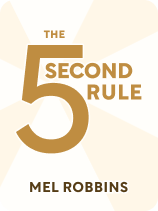

This article is an excerpt from the Shortform book guide to "The 5 Second Rule" by Mel Robbins. Shortform has the world's best summaries and analyses of books you should be reading.
Like this article? Sign up for a free trial here.
Does anxiety control your life? How does the 5 Second Rule regulate anxiety?
In The 5 Second Rule, Mel Robbins explains that the Rule (when combined with other methods of coping) can help you calm yourself when you feel fearful and anxious. She provides a few methods for managing anxiety that are useful for anybody.
Below we’ll explore the 5 Second Rule’s anxiety strategies to calm your mind.
1. Manage Mild Anxiety Using Gratitude
First, Robbins claims that when you’re feeling worried, intentionally thinking of something you’re grateful for can help you calm down. Thinking about the good things in your life causes your brain to release dopamine, naturally soothing your mood by altering your brain chemistry.
To implement the 5 Second Rule’s anxiety method, Robbins suggests counting backward from five to one, then thinking of something you’re grateful for. For example, if you’re worried about losing touch with a friend who’s moving away and you find yourself imagining the end of your friendship, count down from five to one and, when you get to one, think of how grateful you are to have spent so much time with this friend.
(Shortform note: Studies show that gratitude has a greater effect on the brain than just releasing dopamine. Research shows that practicing gratitude rewires the brain’s neural pathways, altering the way we see the world in the long term: We’re more likely to focus on the positive aspects of life. Using the Rule to practice gratitude is a great way to work this practice into your life; alternatively, you could keep a daily gratitude journal, express gratitude in conversations with others, and use more grateful language from day to day.)
2. Reframe Intense Anxiety as Excitement
Robbins explains that sometimes, when anxiety is particularly intense, you won’t be able to simply redirect your thoughts toward something you’re thankful for. When you’re feeling so anxious that your body engages its fight-or-flight response, trying to suppress worrying thoughts will only make the anxiety worse. In these cases, you need a different method to handle anxiety: reframing it as excitement.
According to Robbins, when you have intense anxiety, your brain seeks to identify a specific threat around you as an explanation for why your body feels this way. If your brain can’t identify a threat, it’ll see this as a sign of more danger, causing you to spiral into more intense anxiety or even a panic attack.
However, because anxiety and excitement cause the same physical responses in the body (such as increased heart rate and sweaty palms), telling yourself that you’re excited rather than anxious can convince your brain that there’s no threat to worry about, halting the cycle of escalating anxiety. To implement this strategy, count down from five to interrupt your anxious thoughts, then start telling yourself out loud how excited you are, over and over, until your brain believes it.
| Reframe More Than Anxiety Robbins’s process of “anxiety reappraisal” is just one form of the broader skill of “cognitive reappraisal.” In The Charisma Myth, Olivia Fox Cabane argues that this strategy is effective at regulating any emotion in any situation: Just as you can soothe anxiety by teaching your brain to believe “I’m excited,” you can nudge yourself toward any emotional state you want by inventing new interpretations of the world around you. Cabane explains how to practice cognitive reappraisal: When a situation pushes you into an unpleasant or unproductive emotional state, first, identify what emotional state you’d like to feel instead. Then, ask yourself, “What would have to be true for me to feel that way?” and imagine that reality in as much sensory detail as possible. Although you may feel foolish imagining a version of the world that’s almost certainly inaccurate, you’ll feel your mood shift because the brain interprets imagined details as if it really perceived them. According to Cabane, since you’re not trying to suppress whatever emotions you’re feeling, this strategy can defuse a wide range of intense negative emotions, even ones that are deeply rooted in the body. For example, imagine you just finished a meeting at work. Throughout the meeting, whenever you made a suggestion, your coworkers ignored or casually dismissed it without due consideration, and you’re furious at them for acting so condescendingly. You know this boiling anger will make working together with your coworkers more difficult, so you use cognitive reappraisal to cool your rage: You ask yourself, “What if my coworkers weren’t acting condescendingly? What if they were so nervous that no one would like their ideas that they weren’t even thinking about me?” By imagining this alternate reality, you feel yourself becoming calm enough to work productively with your coworkers (or to constructively confront them about their behavior). |
3. Visualize the Future to Avoid Anxiety
Alternatively, count down from five then visualize a specific image of something in the near future that you’re excited about. Robbins asserts that this latter strategy is particularly effective in conquering specific recurring fears, when you can see the anxious situation coming and decide on an exciting scene to imagine before you start feeling anxious.
For example, if you know you’re afraid of parties with a lot of people, and you’ve been invited to a big party, you can make a plan: If you start feeling anxious before the party, you’ll visualize talking to your best friend at the party. Then, when you do start feeling anxious, you can imagine chatting pleasantly with your friend, convincing your brain that the physical sensations you feel are just excitement to see them.
(Shortform note: To permanently conquer fears that are too intense for you to defuse with anxiety reappraisal, you may want to try exposure therapy. In exposure therapy, you interact with your fears in a safe environment with the help of a trained professional. This repeated exposure will ideally get you used to confronting your fears, weaken your learned fearful associations with your fears, and show you that you have the strength to conquer your fears.)

———End of Preview———
Like what you just read? Read the rest of the world's best book summary and analysis of Mel Robbins's "The 5 Second Rule" at Shortform.
Here's what you'll find in our full The 5 Second Rule summary:
- Why counting down from five to one will help you assert agency over your life
- The different ways you can use the 5-Second Rule
- How to figure out what your passions are and work toward them





